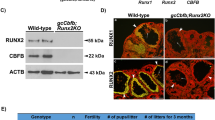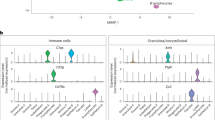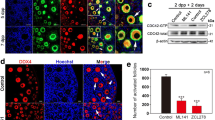Abstract
The transcription factor NFκB has been associated with the timing of menopause in a large human genome-wide association study. Furthermore, preclinical studies demonstrate that loss of Tumor necrosis factor alpha (Tnfα) or its receptor Tnfr2 slows primordial follicle growth activation (PFGA). Although Tnfα:receptor signaling stimulates NFκB and may mechanistically link these findings, very little is known about NFκB signaling in PFGA. Because signaling downstream of Tnfα/Tnfr2 ligand/receptor interaction has not been interrogated as relates to PFGA, we evaluated the expression of key NFκB signaling proteins in primordial and growing follicles, as well as during ovarian aging. We show that key members of the NFκB pathway, including subunits, activating kinases, and inhibitory proteins, are expressed in the murine ovary. Furthermore, the subunits p65 and p50, and the cytosolic inhibitory proteins IκBα and IκBβ, are present in ovarian follicles, including at the primordial stage. Finally, we assessed PFGA in genetically modified mice (AKBI) previously demonstrated to be resistant to inflammatory stress-induced NFκB activation due to overexpression of the NFκB inhibitory protein IκBβ. Consistent with the hypothesis that NFκB plays a key role in PFGA, AKBI mice exhibit slower PGFA than wild-type (WT) controls, and their ovaries contain nearly twice the number of primordial follicles as WT both at early and late reproductive ages. These data provide mechanistic insight on the control of PFGA and suggest that targeting NFκB at the level of IκB proteins may be a tractable route to slowing the rate of PFGA in women faced with early ovarian demise.









Similar content being viewed by others
References
Bertoldo MJ, Walters KA, Ledger WL, Gilchrist RB, Mermillod P, Locatelli Y. In-vitro regulation of primordial follicle activation: challenges for fertility preservation strategies. Reprod BioMed Online. 2018;36(5):491–9. https://doi.org/10.1016/j.rbmo.2018.01.014.
Kallen A, Polotsky AJ, Johnson J. Untapped reserves: controlling primordial follicle growth activation. Trends Mol Med. 2018;24(3):319–31. https://doi.org/10.1016/j.molmed.2018.01.008.
Reddy P, Zheng W, Liu K. Mechanisms maintaining the dormancy and survival of mammalian primordial follicles. Trends Endocrinol Metab. 2010;21(2):96–103. https://doi.org/10.1016/j.tem.2009.10.001.
Zhou J, Ching YQ, Chng WJ. Aberrant nuclear factor-kappa B activity in acute myeloid leukemia: from molecular pathogenesis to therapeutic target. Oncotarget. 2015;6(8):5490–500. https://doi.org/10.18632/oncotarget.3545.
Thomson TC, Fitzpatrick KE, Johnson J. Intrinsic and extrinsic mechanisms of oocyte loss. Mol Hum Reprod. 2010;16(12):916–27. https://doi.org/10.1093/molehr/gaq066.
Tilly JL, Kowalski KI, Johnson AL, Hsueh AJ. Involvement of apoptosis in ovarian follicular atresia and postovulatory regression. Endocrinology. 1991;129(5):2799–801. https://doi.org/10.1210/endo-129-5-2799.
Gold EB. The timing of the age at which natural menopause occurs. Obstet Gynecol Clin N Am. 2011;38(3):425–40. https://doi.org/10.1016/j.ogc.2011.05.002.
Nelson LM. Clinical practice. Primary ovarian insufficiency. N Engl J Med. 2009;360(6):606–14. https://doi.org/10.1056/NEJMcp0808697.
Cobin RH, Goodman NF, Committee ARES. American Association of Clinical Endocrinologists and American College of Endocrinology position statement on menopause—2017 update. Endocr Pract. 2017;23(7):869–80. https://doi.org/10.4158/EP171828.PS.
Gompel A, Boutouyrie P, Joannides R, Christin-Maitre S, Kearny-Schwartz A, Kunz K, et al. Association of menopause and hormone replacement therapy with large artery remodeling. Fertil Steril. 2011;96(6):1445–50. https://doi.org/10.1016/j.fertnstert.2011.09.010.
Hashimoto M, Miyao M, Akishita M, Hosoi T, Toba K, Kozaki K, et al. Effects of long-term and reduced-dose hormone replacement therapy on endothelial function and intima–media thickness in postmenopausal women. Menopause. 2002;9(1):58–64. https://doi.org/10.1097/00042192-200201000-00009.
Hadji P. Menopausal symptoms and adjuvant therapy-associated adverse events. Endocr Relat Cancer. 2008;15(1):73–90. https://doi.org/10.1677/ERC-07-0193.
Shuster LT, Rhodes DJ, Gostout BS, Grossardt BR, Rocca WA. Premature menopause or early menopause: long-term health consequences. Maturitas. 2010;65(2):161–6. https://doi.org/10.1016/j.maturitas.2009.08.003.
Durlinger AL, Kramer P, Karels B, de Jong FH, Uilenbroek JT, Grootegoed JA, et al. Control of primordial follicle recruitment by anti-Mullerian hormone in the mouse ovary. Endocrinology. 1999;140(12):5789–96. https://doi.org/10.1210/endo.140.12.7204.
Pankhurst MW. A putative role for anti-Mullerian hormone (AMH) in optimising ovarian reserve expenditure. J Endocrinol. 2017;233(1):R1–R13. https://doi.org/10.1530/JOE-16-0522.
Kano M, Sosulski AE, Zhang L, Saatcioglu HD, Wang D, Nagykery N, et al. AMH/MIS as a contraceptive that protects the ovarian reserve during chemotherapy. Proc Natl Acad Sci U S A. 2017;114(9):E1688–E97. https://doi.org/10.1073/pnas.1620729114.
Cheng Y, Kim J, Li XX, Hsueh AJ. Promotion of ovarian follicle growth following mTOR activation: synergistic effects of AKT stimulators. PLoS One. 2015;10(2):e0117769. https://doi.org/10.1371/journal.pone.0117769.
Jagarlamudi K, Liu L, Adhikari D, Reddy P, Idahl A, Ottander U, et al. Oocyte-specific deletion of Pten in mice reveals a stage-specific function of PTEN/PI3K signaling in oocytes in controlling follicular activation. PLoS One. 2009;4(7):e6186. https://doi.org/10.1371/journal.pone.0006186.
Reddy P, Liu L, Adhikari D, Jagarlamudi K, Rajareddy S, Shen Y, et al. Oocyte-specific deletion of Pten causes premature activation of the primordial follicle pool. Science. 2008;319(5863):611–3. https://doi.org/10.1126/science.1152257.
Kawamura K, Cheng Y, Suzuki N, Deguchi M, Sato Y, Takae S, et al. Hippo signaling disruption and Akt stimulation of ovarian follicles for infertility treatment. Proc Natl Acad Sci U S A. 2013;110(43):17474–9. https://doi.org/10.1073/pnas.1312830110.
Novella-Maestre E, Herraiz S, Rodriguez-Iglesias B, Diaz-Garcia C, Pellicer A. Short-term PTEN inhibition improves in vitro activation of primordial follicles, preserves follicular viability, and restores AMH levels in cryopreserved ovarian tissue from cancer patients. PLoS One. 2015;10(5):e0127786. https://doi.org/10.1371/journal.pone.0127786.
Castrillon DH, Miao L, Kollipara R, Horner JW, DePinho RA. Suppression of ovarian follicle activation in mice by the transcription factor Foxo3a. Science. 2003;301(5630):215–8. https://doi.org/10.1126/science.1086336.
Liu L, Rajareddy S, Reddy P, Du C, Jagarlamudi K, Shen Y, et al. Infertility caused by retardation of follicular development in mice with oocyte-specific expression of Foxo3a. Development. 2007;134(1):199–209. https://doi.org/10.1242/dev.02667.
Greenfeld CR, Roby KF, Pepling ME, Babus JK, Terranova PF, Flaws JA. Tumor necrosis factor (TNF) receptor type 2 is an important mediator of TNF alpha function in the mouse ovary. Biol Reprod. 2007;76(2):224–31. https://doi.org/10.1095/biolreprod.106.055509.
Cui LL, Yang G, Pan J, Zhang C. Tumor necrosis factor alpha knockout increases fertility of mice. Theriogenology. 2011;75(5):867–76. https://doi.org/10.1016/j.theriogenology.2010.10.029.
Stolk L, Perry JR, Chasman DI, He C, Mangino M, Sulem P, et al. Meta-analyses identify 13 loci associated with age at menopause and highlight DNA repair and immune pathways. Nat Genet. 2012;44(3):260–8. https://doi.org/10.1038/ng.1051.
Hayden MS, Ghosh S. Signaling to NF-kappaB. Genes Dev. 2004;18(18):2195–224. https://doi.org/10.1101/gad.1228704.
Biswas G, Anandatheerthavarada HK, Zaidi M, Avadhani NG. Mitochondria to nucleus stress signaling: a distinctive mechanism of NFkappaB/Rel activation through calcineurin-mediated inactivation of IkappaBbeta. J Cell Biol. 2003;161(3):507–19. https://doi.org/10.1083/jcb.200211104.
Xiao CW, Ash K, Tsang BK. Nuclear factor-kappaB-mediated X-linked inhibitor of apoptosis protein expression prevents rat granulosa cells from tumor necrosis factor alpha-induced apoptosis. Endocrinology. 2001;142(2):557–63. https://doi.org/10.1210/endo.142.2.7957.
Yuan S, Wen J, Cheng J, Shen W, Zhou S, Yan W, et al. Age-associated up-regulation of EGR1 promotes granulosa cell apoptosis during follicle atresia in mice through the NF-kappaB pathway. Cell Cycle. 2016;15(21):2895–905. https://doi.org/10.1080/15384101.2016.1208873.
Valdez KE, Turzillo AM. Regulation of nuclear factor-kappaB (NF-kappaB) activity and apoptosis by estradiol in bovine granulosa cells. Mol Cell Endocrinol. 2005;243(1–2):66–73. https://doi.org/10.1016/j.mce.2005.09.004.
Chu S, Nishi Y, Yanase T, Nawata H, Fuller PJ. Transrepression of estrogen receptor beta signaling by nuclear factor-kappab in ovarian granulosa cells. Mol Endocrinol. 2004;18(8):1919–28. https://doi.org/10.1210/me.2004-0021.
Gonzalez-Navarrete F, Eisner V, Morales P, Castro O, Pommer R, Quiroga C, et al. Tumor necrosis factor-alpha activates nuclear factor-kappaB but does not regulate progesterone production in cultured human granulosa luteal cells. Gynecol Endocrinol. 2007;23(7):377–84. https://doi.org/10.1080/09513590701444839.
Pavlova S, Klucska K, Vasicek D, Kotwica J, Sirotkin AV. Transcription factor NF-kappaB (p50/p50, p65/p65) controls porcine ovarian cells functions. Anim Reprod Sci. 2011;128(1–4):73–84. https://doi.org/10.1016/j.anireprosci.2011.09.005.
McKenna S, Butler B, Jatana L, Ghosh S, Wright CJ. Inhibition of IkappaBbeta/NFkappaB signaling prevents LPS-induced IL1beta expression without increasing apoptosis in the developing mouse lung. Pediatr Res. 2017;82(6):1064–72. https://doi.org/10.1038/pr.2017.182.
McKenna S, Wright CJ. Inhibiting IkappaBbeta-NFkappaB signaling attenuates the expression of select pro-inflammatory genes. J Cell Sci. 2015;128(11):2143–55. https://doi.org/10.1242/jcs.168351.
Cheng JD, Ryseck RP, Attar RM, Dambach D, Bravo R. Functional redundancy of the nuclear factor kappa B inhibitors I kappa B alpha and I kappa B beta. J Exp Med. 1998;188(6):1055–62. https://doi.org/10.1084/jem.188.6.1055.
R Core Team. R: A language and environment for statistical computing. R Foundation for Statistical Computing, Vienna, Austria https://www.R-project.org. Accessed May 20 2020.
Tarnawa ED, Baker MD, Aloisio GM, Carr BR, Castrillon DH. Gonadal expression of Foxo1, but not Foxo3, is conserved in diverse mammalian species. Biol Reprod. 2013;88(4):103. https://doi.org/10.1095/biolreprod.112.105791.
Uslu B, Dioguardi CC, Haynes M, Miao DQ, Kurus M, Hoffman G, et al. Quantifying growing versus non-growing ovarian follicles in the mouse. J Ovarian Res. 2017;10(1):3. https://doi.org/10.1186/s13048-016-0296-x.
Hoffmann A, Levchenko A, Scott ML, Baltimore D. The IkappaB-NF-kappaB signaling module: temporal control and selective gene activation. Science. 2002;298(5596):1241–5. https://doi.org/10.1126/science.1071914.
Werner SL, Barken D, Hoffmann A. Stimulus specificity of gene expression programs determined by temporal control of IKK activity. Science. 2005;309(5742):1857–61. https://doi.org/10.1126/science.1113319.
Yuan L, Lv Y, Li H, Gao H, Song S, Zhang Y, et al. Deubiquitylase OTUD3 regulates PTEN stability and suppresses tumorigenesis. Nat Cell Biol. 2015;17(9):1169–81. https://doi.org/10.1038/ncb3218.
de Castro Barbosa ML, da Conceicao RA, Fraga AGM, Camarinha BD, de Carvalho Silva GC, Lima AGF, et al. NF-kappaB signaling pathway inhibitors as anticancer drug candidates. Anti Cancer Agents Med Chem. 2017;17(4):483–90. https://doi.org/10.2174/1871520616666160729112854.
Fuchs O. Targeting of NF-kappaB signaling pathway, other signaling pathways and epigenetics in therapy of multiple myeloma. Cardiovasc Hematol Disord Drug Targets. 2013;13(1):16–34. https://doi.org/10.2174/1871529x11313010003.
Acknowledgments
Sarah McKenna and Leanna Nguyen provided support for experiments performed during this study. Drs. Benjamin Bitler and Damian Guerra are acknowledged for providing invaluable feedback on the manuscript prior to submission.
Funding
C.W. acknowledges support by NIH R01HL132941. J.J. is supported by CU-Anschutz Department of Obstetrics and Gynecology Research Funds.
Author information
Authors and Affiliations
Contributions
C.J.W., A.J.P., A.K., J.J. conception and design of research; C.J.W., E.L.C., J.S., E.B., P.K.S., M.A.Z., J.J. performed experiments; C.J.W., E.L.C., J.S., E.B., P.K.S., M.A.Z., A.K., J.J. analyzed data; C.J.W., E.L.C., J.S., E.B., P.K.S., M.A.Z., J.J. interpreted results of experiments; J.J. drafted the manuscript; C.J.W., E.L.C., J.S., J.J. prepared figures; C.J.W., J.J. edited and revised manuscript; C.J.W., E.L.C., J.S., E.B., P.K.S., M.A.Z., A.J.P., A.K., J.J. approved final version of manuscript.
Corresponding authors
Ethics declarations
Conflict of Interest
The authors declare that they have no competing interests.
Additional information
Publisher’s Note
Springer Nature remains neutral with regard to jurisdictional claims in published maps and institutional affiliations.
Rights and permissions
About this article
Cite this article
Wright, C.J., Cari, E.L., Sandoval, J. et al. Control of Murine Primordial Follicle Growth Activation by IκB/NFκB Signaling. Reprod. Sci. 27, 2063–2074 (2020). https://doi.org/10.1007/s43032-020-00225-3
Received:
Accepted:
Published:
Issue Date:
DOI: https://doi.org/10.1007/s43032-020-00225-3




